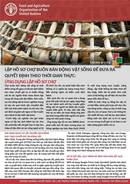Publications
Results and recommendations from the implementation of the Global Bioenergy Partnership indicators
The Global Bioenergy Partnership (GBEP) has produced a set of twenty-four indicators for the assessment and monitoring of bioenergy sustainability at the national level. The GBEP indicators are intended to inform policymakers about the environmental, social and economic sustainability aspects of the bioenergy sector in their country and guide them towards policies that foster sustainable development. FAO, which is among the founding members of GBEP, supported the implementation of the GBEP indicators in Viet Nam, with generous support from the International Climate Initiative (ICI) of the Federal Ministry of the Environment, Natural Resource, and Nuclear Safety of Germany. This report presents the main results of the implementation of the GBEP indicators in Viet Nam, where the following bioenergy pathways, which were deemed particularly relevant by national stakeholders, were analyzed: ethanol from cassava, and biogas at both household and industrial levels. In addition to offering interesting insights into the sustainability of the selected bioenergy pathways, the implementation of the GBEP indicators provided Viet Nam with an understanding of how to establish the means of a long term, periodic monitoring of its domestic bioenergy sector based on the GBEP indicators. Furthermore, it provided a few lessons learnt about how to apply the indicators as a tool for sustainable development and how to enhance their practicality. The work undertaken in the context of this project falls under FAO’s Strategic Objectives 2 and 4.
Characterizing livestock markets for real-time decision-making: the Market Profiling Application
Livestock markets are a “hotspot” of disease risk along the value chain as many animals of different origin are combined into a single location. Moreover, as markets occur during periods of high stress for animals (e.g. transport), the need to identify and monitor the risk of disease transmission becomes particularly urgent. Traditionally, studies documenting the risk of disease spread through livestock markets have mostly been limited to static data gathering efforts and obsolete processing technologies. As a result, the findings rarely have practical significance at the field level, where disease control and prevention actions are applied. In addition, veterinary services are facing increasing pressure from emerging zoonotic and transboundary diseases. As a result, it is becoming increasingly important to prioritize response activities in times of reduced resource allocation. The Market Profiling Application (MPA) developed by the Food and Agriculture Organization of the United Nations (FAO) is an online, dynamic, real-time application to systematically collect, display and analyse epidemiologically relevant market data.The factsheet has been translated into Vietnamese for easy usage by Vietnamese researchers, scientists, academia, institutes, etc.
Rice–rice and rice–shrimp production : A gender perspective on labour, time use and access to technologies and services in southern Viet Nam
Within the framework of supporting sustainable production in a context of rural transformation, this study focuses on smallholder farms in Soc Trang, southern Viet Nam. Its purpose is to highlight and compare women and men’s contributions to two integrated, rice-based farming systems and explore how gender norms affect labour and access to productive inputs, technologies and services: the first is a more traditional production system centred on double rice cropping, while the second adopted an innovative practice which integrates rice and aquaculture (shrimp farming). The conclusion introduces a set of key findings and research, policy and project implementation recommendations.
El Niño Event in Viet Nam
Since late 2015 Viet Nam has been impacted by the El Niño phenomenon resulting in the Central Highlands, Southern Central and Mekong Delta regions experiencing their most severe drought in the past 90 years. Drought and saltwater intrusion from coastal areas have caused significant damage and threaten national agricultural production and people’s livelihoods. In this regard, FAO conducted a more in-depth assessment focusing on the impact of the drought and saltwater intrusion on agriculture and sub-sectors (crops, livestock, fisheries and aquaculture), with particular attention on implications related to livelihoods and food security across the affected population and most vulnerable groups (women, ethnic minorities). FAO led this assessment in partnership with the MARD, particularly the departments of Crop Production, Livestock Production as well as Natural Disaster Prevention and Control, Dfish, provincial DARDs, WFP, UN Women and Women’s Union.
One Health : Seeing around corners : Regional communication strategy framework against infectious diseases in Asia and the Pacific 2011-2016 : English version
One Health: Seeing around corners, the regional communication strategy framework against infectious diseases in Asia and the Pacific 2011-2016, has been developed through a collaborative process led by the Food and Agriculture Organization of the United Nations, with major inputs from United Nations Childrens Fund, the United Nations System Influenza Coordination and the erstwhile Academy forEducational Development, as well as feedback from the World Health Organization South East Asia Regional Office. The primary technical and strategic framework was developed by FAO, and vetted and modified after inputs by collaborating partners.The development of the document has been supported by funds from the United States Agency for International Development, the Eropean Union and the Asian Development Bank.





